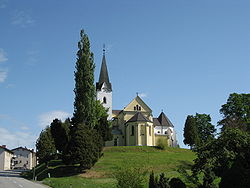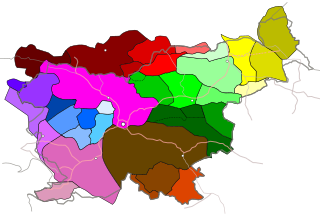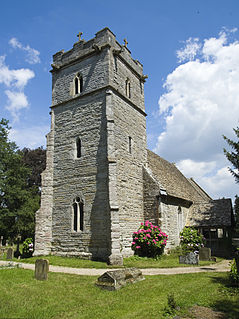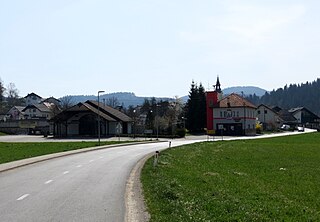| Sveti Jurij Jurij (1955–1990) | |
|---|---|
 | |
| Coordinates: 46°47′52.83″N16°2′10.55″E / 46.7980083°N 16.0362639°E Coordinates: 46°47′52.83″N16°2′10.55″E / 46.7980083°N 16.0362639°E | |
| Country | |
| Traditional region | Prekmurje |
| Statistical region | Mura |
| Municipality | Rogašovci |
| Area | |
| • Total | 3.92 km2 (1.51 sq mi) |
| Elevation | 236 m (774 ft) |
| Population (2016) | |
| • Total | 463 |
| [1] | |
Sveti Jurij (pronounced [ˈsʋeːti ˈjuːɾii̯] ; Hungarian : Vízlendva, [2] German : Sankt Georgen, [3] Prekmurje Slovene: Sveti Güri [4] or Sveti Jürij [5] ) is a village in the Municipality of Rogašovci in the Prekmurje region of northeastern Slovenia. [6]

Hungarian is a Finno-Ugric language spoken in Hungary and several neighbouring countries. It is the official language of Hungary and one of the 24 official languages of the European Union. Outside Hungary it is also spoken by communities of Hungarians in the countries that today make up Slovakia, western Ukraine (Subcarpathia), central and western Romania (Transylvania), northern Serbia (Vojvodina), northern Croatia, and northern Slovenia. It is also spoken by Hungarian diaspora communities worldwide, especially in North America and in Israel. Like Finnish and Estonian, Hungarian belongs to the Uralic language family. With 13 million speakers, it is its largest member in terms of speakers.

German is a West Germanic language that is mainly spoken in Central Europe. It is the most widely spoken and official or co-official language in Germany, Austria, Switzerland, South Tyrol (Italy), the German-speaking Community of Belgium, and Liechtenstein. It is also one of the three official languages of Luxembourg and a co-official language in the Opole Voivodeship in Poland. The languages which are most similar to German are the other members of the West Germanic language branch: Afrikaans, Dutch, English, the Frisian languages, Low German/Low Saxon, Luxembourgish, and Yiddish. There are also strong similarities in vocabulary with Danish, Norwegian and Swedish, although those belong to the North Germanic group. German is the second most widely spoken Germanic language, after English.

Prekmurje Slovene, also known as the Prekmurje dialect, East Slovene, or Wendish, is a Slovene dialect belonging to a Pannonian dialect group of Slovene. It is used in private communication, liturgy, and publications by authors from Prekmurje. It is spoken in the Prekmurje region of Slovenia and by the Hungarian Slovenes in Vas County in western Hungary. It is closely related to other Slovene dialects in neighboring Slovene Styria, as well as to Kajkavian with which it retains partial mutual intelligibility and forms a dialect continuum with other South Slavic languages.
















